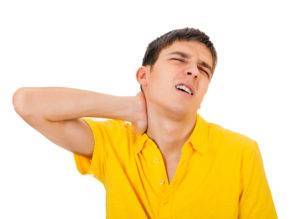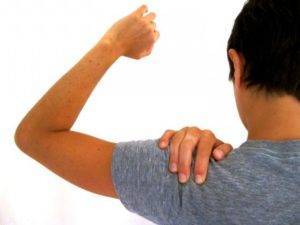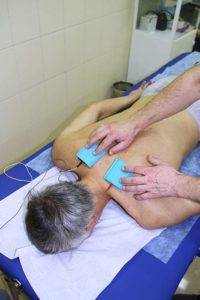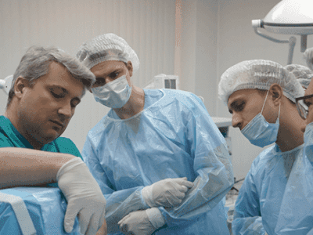
Currently, according to medical statistics, almost all people over 25-30 years old complain about symptoms of cervical fibroids. The disease affects one part of the spine more often than other parts. Pathology is a progressive degenerative process that affects the disc and vertebrae in the neck. The disease is equally common in men and women.
This is a dangerous and complicated form of bone necrosis, as there are large blood vessels in the neck that supply the brain and a large number of nerve endings. Endocrine disorders and blood flow lead to a decrease in the supply of oxygen and nutrients to the brain.
Symptoms
Symptoms of cervical necrosis are more obvious than other parts of the spine, even with mild injuries. This is due to the proximity of the cervical vertebrae and the low height of the disc. This anatomical feature contributes to the fact that with bone necrosis, nerve ends, spinal cord and blood vessels are often more compressed.
General Symptoms:
- pain syndrome
- ;
- weak and decreased sensitivity in the upper extremities;
- restricts neck movement;
- impaired ability to coordinate movements;
- frequent dizziness;
- general weakness;
- impaired function of the sensory organs (hearing, sight, touch, taste).

Pain is usually localized in the neck, spreading to the back of the head, shoulders, and arms. The upper extremities suffer pain if the nerve roots responsible for their internal growth are pinched by the damaged vertebra. Post-headache pain is caused by stiffness in the neck muscles attached to the occipital bone, and the decrease in blood circulation in this area.
A weak arm condition is observed in the patient if the nerve root is involved in the pathological process, providing support for the muscular structure of the upper extremities.
Mobility restriction and the characteristic clumping noise characteristic of neck rotation or tilt occurs if bone growth occurs on the cervical vertebra, the height of the disc is reduced and the joints betweenaffected vertebrae.
The vertebrae of the neck have cross-sectional processes that form a conduit in which the artery that feeds the brain runs. With cervical spondylolisthesis, the vertebrae are displaced, connective tissue develops on them. This results in compression of the cervical artery, reducing blood supply to the cerebellum and back parts of the brain. The result is a person experiencing frequent dizziness, impaired coordination of movements, and general weakness. In severe cases, if the artery is involved in a pathological process or is severely squeezed, the blood supply to the cerebellum, occipital region and brain stem is significantly reduced. In this case, the function of auditory organs, vision impairment, tongue and fingers numb.
Symptoms of the disease also depend on which of the eight vertebrae is affected by degeneration or inflammation. Sensitivity and motor disorders are caused by damage to the spinal roots, which are affected by several vertebrae. Depending on this, the following manifestations of cervical bone necrosis are observed:
- first vertebra - the neck and occipital part of the head are numb, their sensitivity decreases; Second
- - soreness in the occipital and occipital regions; third
- - pain and decreased sensitivity in the neck where the spinal roots are compressed, the intensity of taste sensation decreases, language disturbances; The fourth
- - pain radiating to the shoulder, the fibula, the patient is anxious of a heart attack, respiratory disturbances, hypotonia of the neck muscles; fifth
- - pain noted in the neck, for the outer surface of the shoulder; sixth
- - pain in the neck radiating to the scapula, felt in the forearm and thumb;
- Saturday - pain appearing in the shoulder blade, behind the shoulder, forearm and fingers (from Monday to Wednesday); Eighth
- - pain spreading from neck to shoulder, forearm and little finger.
There are four levels of cervical necrosis, depending on the severity of the damage. These are not the stages of the disease but the severity of symptoms, due to the prevalence of the pathological process, which vertebrae affect.
- At the first level, clinical symptoms are absent or very minimal. The patient complains of mild pain that is worse with head movements. Treatment that begins at this stage of the disease will be effective. However, people often ignore alarming or inaccessible symptoms and should not seek medical attention.
- Exacerbation of the pathological process increases the symptoms. In the second stage, the pain becomes more pronounced, spreading to the upper limbs, shoulder blades. At this stage in the development of degenerative processes, the height of the disc gradually decreases, as a result of which the nerve fibers become compressed. This becomes the cause of increasing pain. The second degree of cervical spondylolisthesis is characterized by the appearance of headaches, impaired health and decreased performance.
- The third degree of cervical fibroids is characterized by herniated formation of the affected disc. The ability to move the neck is limited, and when palpable, the patient feels severe pain. With the spread of the pathological process, the pain becomes continuous, spreading to the upper extremities. There is a feeling of tension in the muscles attached to the occipital bone. Patient complains of frequent dizziness, general weakness, numbness in the hands.
- A fourth degree of cervical degenerative disease is diagnosed when the disc is completely destroyed by the degenerative process. It is replaced with fibrous tissue, which leads to a significant limitation in mobility. The spinal cord and blood vessels in the neck are affected. Such changes are characterized by a significant decrease in blood supply to the cerebellum and the occipital part of the brain. Lack of oxygen leads to impaired coordination of movements, impaired hearing, vision, tongue numbness and language disorders.
Methods of treatment
See your doctor promptly when the first alarm symptoms appear, discomfort in the neck, the reactions from the nervous system will prevent the progression of degenerative changes. Treatment of cervical bone necrosis includes a range of treatments. Among them:
- are taking medication;
- massage;
- physical therapy exercises;
- physical therapy procedures.
The treatment is carried out at home and on an outpatient basis, under the supervision of a doctor. In some cases, more radical methods may be required, after which the patient is hospitalized.
Drug treatment
The following classes of drugs are used to treat necrosis of the cervical spine:
- nonsteroidal anti-inflammatory drugs;
- chondroprotectors; Muscle relaxants
- ;
- drug improves rheological parameters;
- B vitamins
Doctors prescribe anti-inflammatory drugs to reduce the intensity of pain, inflammation and swelling of nerve roots. The chondroprotectors recover damaged cartilage tissue in the disc. Muscle relaxants help relax neck muscles, reduce spasm. Drugs that improve blood flow help restore the reduced blood supply to the brain. B vitamins activate metabolism in nerve tissues. For severe pain, your doctor can prescribe pain relievers. If the patient has severe pain syndrome, then use parenteral pain relievers, after the pain subsides, switch to tablets.
In addition to drugs, patients can use traditional methods to treat cervical bone tumors. Before using them, you need to consult a doctor so that there is no conflict between the drug and non-traditional means. The decoction and infusions from cumin, plantain, and lilac help prevent inflammation and relieve pain.
Physiotherapy

Physiotherapy is an effective way to combat bone necrosis of the cervical spine. It is imperative to treat this disease with such techniques, thus achieving the following results:
- reduced intensity of pain;
- activates restoration of affected bone, cartilage and muscle tissue;
- reduces muscle spasms and strains;
- inflammatory process is stopped;
- improves the delivery of oxygen and nutrients to the affected area and the brain.
The following types of procedures are considered to be the most effective in the treatment of osteonecrosis:
- Drug electrophoresis
- (electric current introduced into the affected area, in addition to activating blood flow and tissue repair, also improves the delivery of the active substance of the drug to the affected tissues too. degenerative process); Ultrasound therapy
- (the metabolism in the affected area is activated, reduces pain, stops inflammation); Stinging therapy
- (reduces puffiness from the affected area, helps reduce pain intensity); Laser therapy
- (improves blood circulation in the area of the pathological process, has an anti-inflammatory effect).
In addition, the doctor can advise acupuncture procedures, atmospheric treatment.
Physical therapy exercises
Exercises are indicated in the period of the disease stop acute manifestations. During exercise, do not get discomfort and soreness.

Complex should be done when the disease is in steady remission to prevent relapses.
- Perform a prone position, raise head and body, support arms. Back straight, breathing deeply and evenly. Hold for a minute or two, then slowly return to your starting position. The number of repetitions is 3.
- Posture - lying on his stomach, hands along the body. Slowly turn your head, trying to touch your ear to the floor. Repeat 6 times on each side.
- Sit or stand, tilt your head while inhaling, try to touch your chest with your chin. As you breathe out, gently pull your head back, looking up at the ceiling. The number of repetitions is 10-15.
- A good exercise to strengthen your neck muscles is to press your forehead against your hands. To achieve the effect, you need to press both palms into forehead and forehead on palms for 30 seconds. Repeat three times.
- Rotate your head in a circle. Exercise should be done slowly and smoothly. Each direction - 10 turns. It is unacceptable to experience dizziness while performing these movements. If this happens, you should stop immediately.
All exercises must be done smoothly, without sudden movement, in case of deteriorating health, nausea or dizziness must stop immediately.
Massage

Treatment prescribed by a doctor in the absence of acute pain, which can only be done by a medically qualified specialist. With such a disease, it is not recommended to contact unprofessional people.
The healing effect of neck massage:
- improves blood and lymph flow in the affected area;
- relaxes muscles, reduces spasm;
- gradually reduced intensity of pain.
Experts use the entire arsenal of massage movements: swipe, massage, tumble, massage and vibrate.
Surgery
Surgery is indicated if conservative treatment has not yielded results within six months, patient has severe pain, signs of nerve fiber damage, and myelopathy. If cervical vertebrae has complications, is stroke-threatening, and has a strong spinal cord compression, surgery is needed.
As indicated, the following types of surgical interventions are used:
- laparoscopic resection - removal of part or all of the disc;
- laminotomy - removal of bone ligaments and overgrowth elements of bone tissue (often in combination with laminoplasty - installation of artificial sheets to expand the spinal canal);
- laser combustion of the disc nucleus - separates the core of the disc with the laser beam simultaneously with the destruction of its debris;
- cold plasma imaging - instead of an endoscope, a long, thin hollow needle is inserted into the disc, through which an electrode is applied to the site of the lesion, acting in a cold plasma.

The neck is a complex organ that contains large blood vessels, the spinal cord. They are easily damaged, so surgical intervention is used in no more than 5% of cases. Surgical treatment is often accompanied by the development of complications. Among them:
- Inflammatory process
- in the tissues or membranes of the spinal cord; osteomyelitis
- ;
- scarring leads to stenosis of the artery and spinal canal.
Neck spine surgery is very difficult and requires a long recovery time. Postoperative recovery takes six months or more.
Precautions
To prevent the development of cervical bone necrosis, it is necessary to:
- tracks the position of the spine and neck;
- has an active, more active lifestyle;
- while exercising, you must be careful, do it correctly, as even minor injuries can affect the state of the musculoskeletal system;
- take proper care of your body while sleeping, buy orthopedic mattresses or surgery;
- to equip the workplace where one spends a lot of time;
- regularly participates in physical education;
- monitors the diet, ensuring the supply of all the useful minerals needed for strong bones, especially magnesium and calcium;
- continuously undergoes acute examinations for the timely detection of osteonecrosis.
Prevention will help prevent degenerative changes in the cervical spine, protecting from pain, dizziness, numbness of the limbs and other unpleasant symptoms.







































